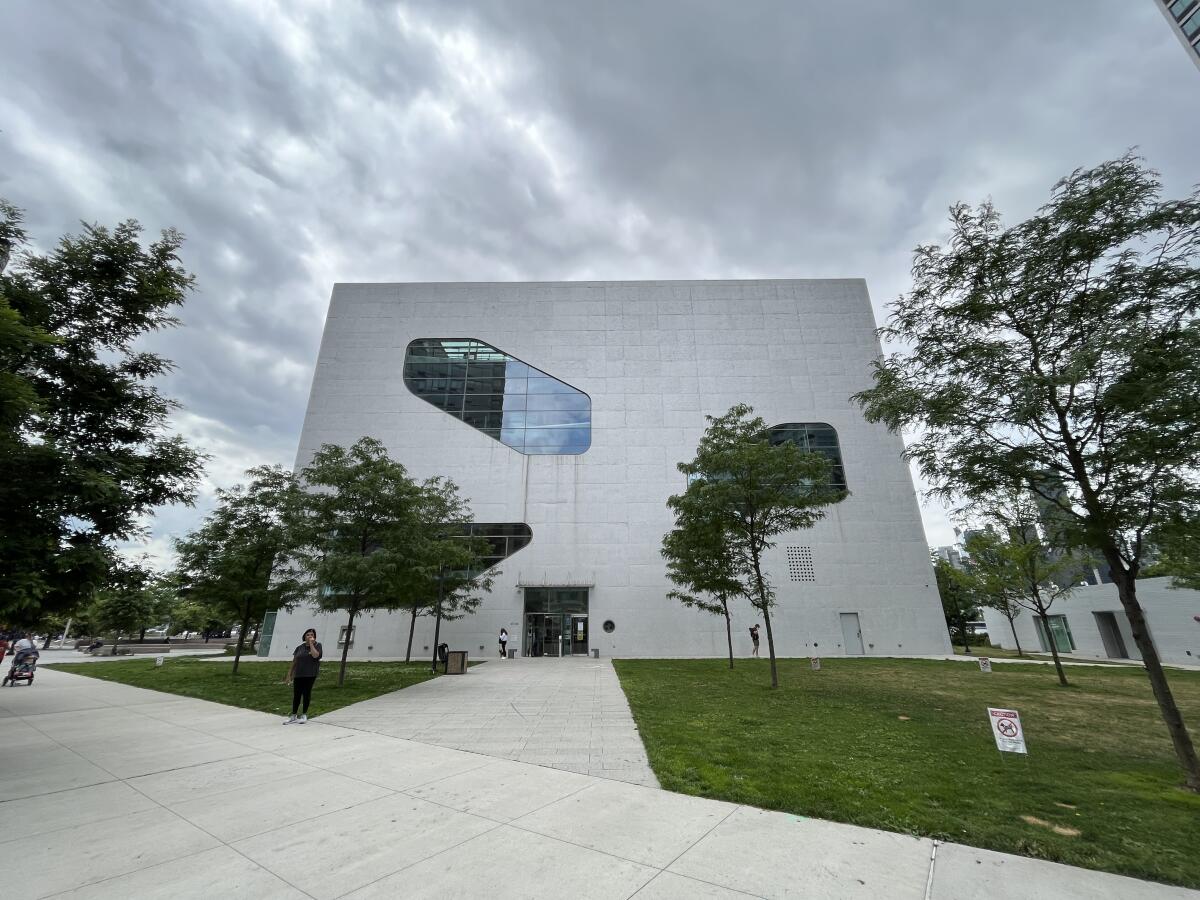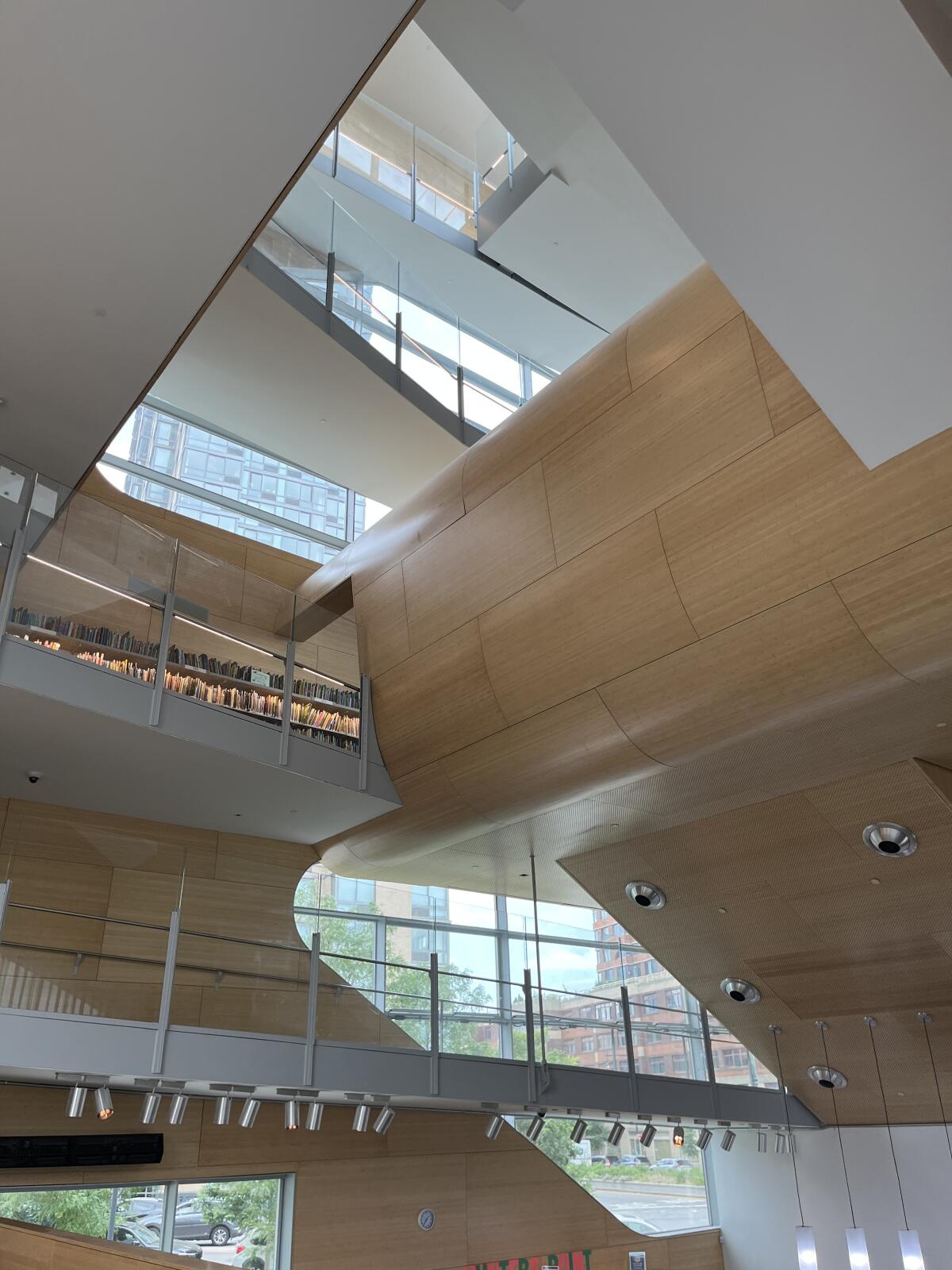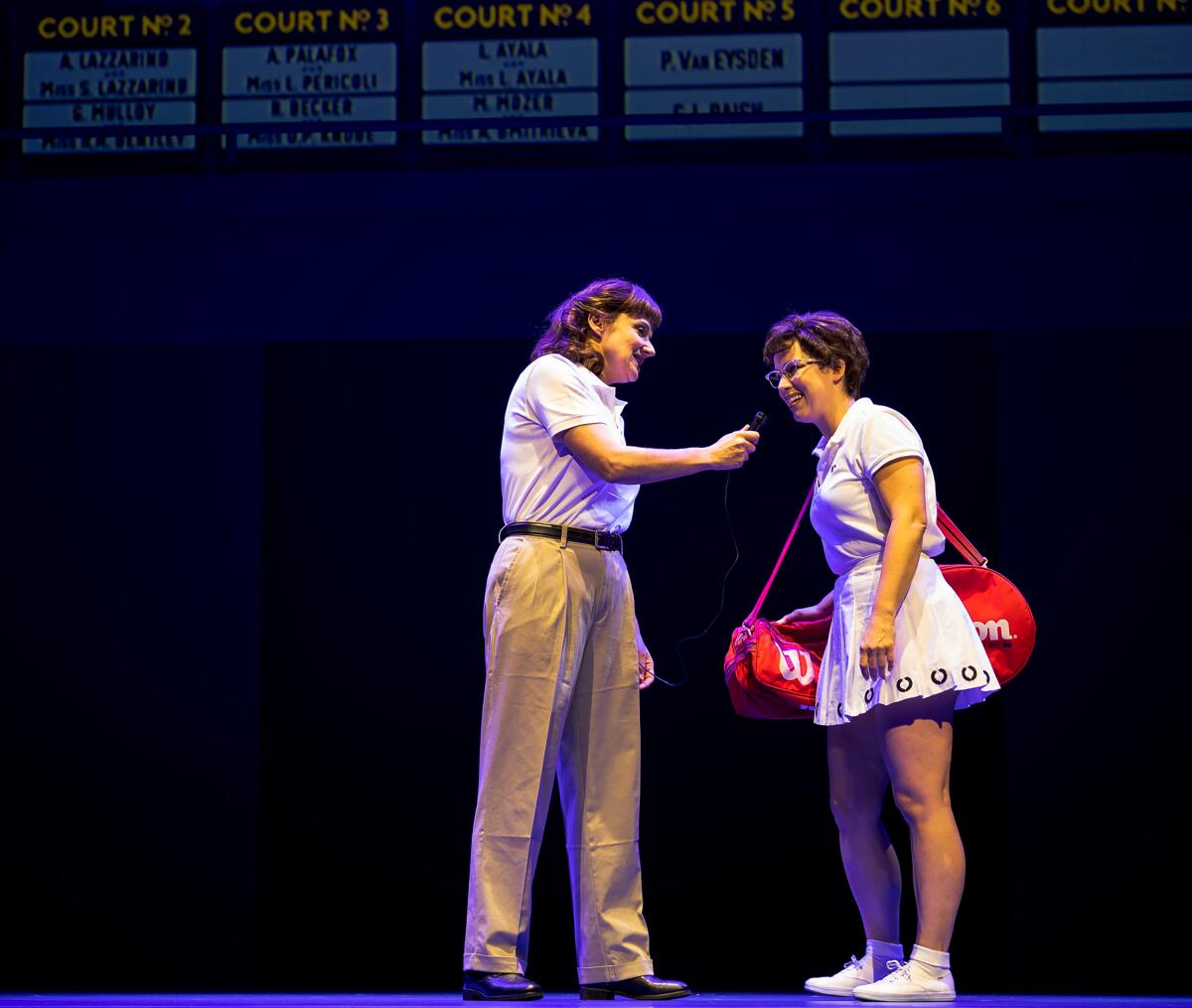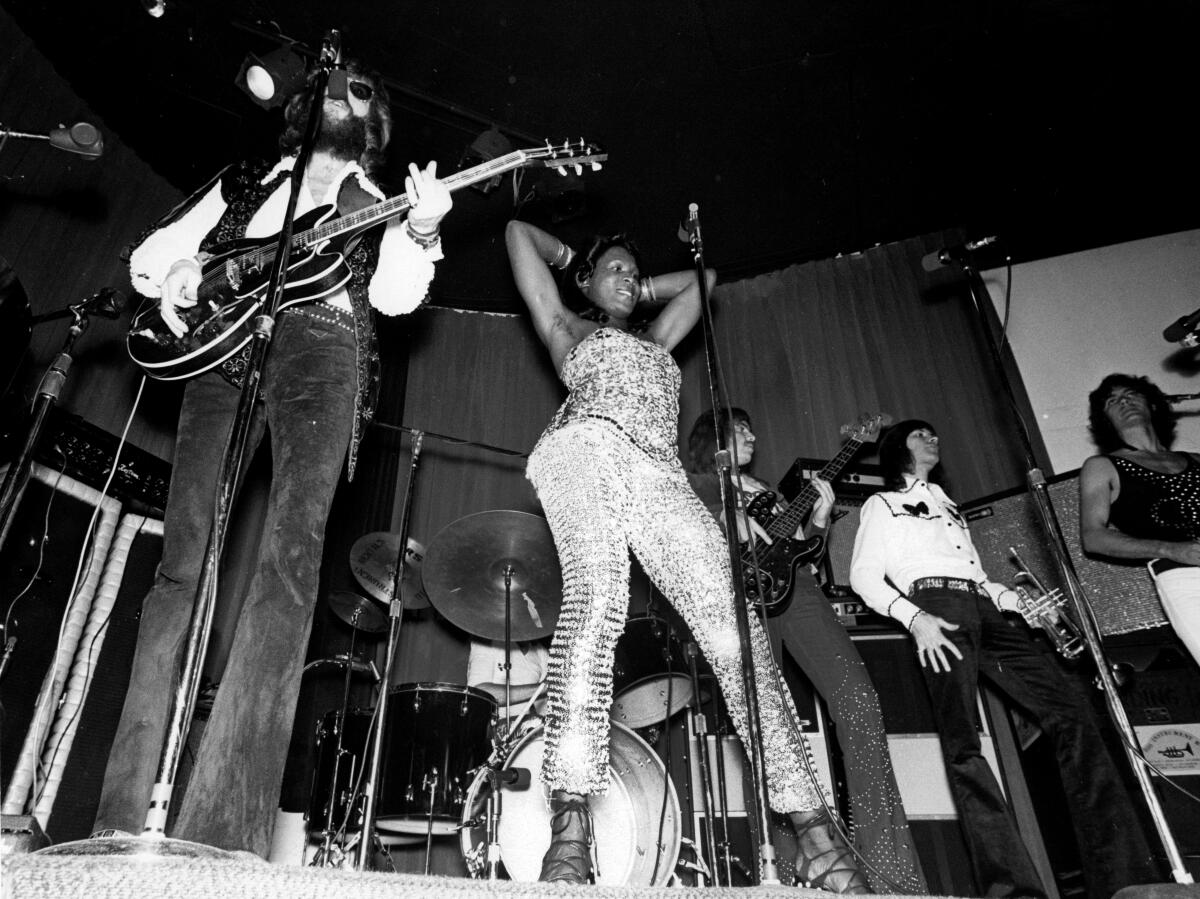How did a New York public library by Steven Holl Architects get accessibility so wrong?

- Share via
It’s Friday, which means the lady that sells burritos from a cooler by the local Catholic church has her chile relleno burritos in stock, which is how I like to roll into the weekend. I’m Carolina A. Miranda, art and design columnist for the Los Angeles Times, and I’m here with all the arts news and cumbias:
Stairs shouldn’t be the only option
I recently traveled to New York City with a family member with mobility issues. Walking with her is a slow and deliberate act in which commonplace fixtures become daunting obstacles: a curb is to be navigated with care; a short flight of steps has to be accounted for with additional travel time. For ease of transit, we stayed near Grand Central Terminal, where I mental-mapped every escalator and elevator in the station.
Grand Central is a challenging building to navigate with mobility issues. Flights of steps cascade down the western side of the main hall. Some elevators are tucked out of sight in an industrial area just off the tracks; others don’t stop on every floor. In some cases, it was easier to exit the station and reenter through another doorway than traverse the building itself.
It was with this experience seared into my able-bodied consciousness that I hopped the East River to pay a visit to the Queens Public Library at Hunters Point, designed by the New York-based Steven Holl Architects.

Critically acclaimed when it opened, the library has for years been in the news over its accessibility problems. Completed in 2019 at a cost of more than $40 million, the building — among other shortcomings — contains a series of stepped mezzanines with book stacks that can only be reached via a flight of stairs. Sharon McLennon-Wier, executive director of the Center for Independence of the Disabled, recently described it in the New York Times as “a monument to stairs.”
In 2019, the center and Tanya Jackson, a woman with mobility issues, sued the library, its board of trustees and the city for discrimination. Late last month, the City of New York filed its own suit against Holl’s office, alleging that the building did not comply with the Americans with Disabilities Act — and demanding $10 million to make fixes.
How a public building constructed in the 21st century, having journeyed through New York City’s laborious approvals process, can emerge so ill-prepared to receive the actual public is mind-boggling. I can forgive Grand Central Terminal its navigational shortcomings; it was completed in 1913. But the Queens Library at Hunters Point was begun two decades after the passage of the ADA.

The library’s accessibility issues are baked into a design that can be awkward to navigate regardless of your mobility.
The building, which rises over the East River waterfront, is an 82-foot-high rectangular prism with asymmetrical puzzle-piece windows. Have a look at the cross-section drawings, and you’ll see an interior of staggered floor plates that resembles a ball run (those architectonic toys in which a marble travels down a series of ramps).
Make the most of L.A.
Get our guide to events and happenings in the SoCal arts scene. In your inbox every Monday and Friday morning.
You may occasionally receive promotional content from the Los Angeles Times.
The layout accommodates a generous atrium at the heart of the building that draws daylight to the ground floor. The light is a nice touch, as is the highly Instagrammable atrium, with its sequence of blonde wood forms that curl in on themselves.
But the atrium eats up a lot of real estate (the entire six-story building is only 22,000 square feet), resulting in passageways that are uncomfortably narrow — think of it as atrium with a building attached. Ascend the stairs from the ground floor into the media section, and you’ll find only a few feet of clearance between banisters and the stacks. A 2019 news report about the building’s problems noted that stroller parking clogged the entrance to the second-floor elevators.
Moreover, the curving atrium walls have made storage a challenge. In the children’s section, I found racks of book carts spilling off of sloped walls into the librarians’ workspace. Right angles might have benefited a structure whose main function is to contain books.

Beyond the ADA compliance issues (which are major), the entire project makes me wonder if any actual librarians were consulted before the construction of the building.
The stepped mezzanines make it appear not. In addition to wheelchairs, the area is also inaccessible to book carts. Was the plan really to require librarians to traipse up and down stairs carrying handfuls of books? These areas have since had their volumes yanked and now sit empty.
How this design missed the mark is a question that will be parsed throughout the legal proceedings. But a simple walk around the library reveals a structure in which architectural gymnastics have elbowed out basic function — an ivory tower that some will only see from afar.
On and off the stage
The news that the Mark Taper Forum is putting a “pause” on its programming for budgetary reasons is sending a shudder through the theater world across the country. The Times’ Jessica Gelt has a smart analysis on whether the Taper is simply the first domino to fall in a form that has been hobbled by the pandemic. Playwright Jeremy O. Harris tells her that the problems go deeper than COVID-19: “There hasn’t been enough innovation or inquiry around how to inspire a new generation of people to go to these spaces, and to find community inside of a theater in their town.”
“Canceling these productions has done real damage to communities here in Los Angeles and nationally, and that damage has to be acknowledged,” writes Larissa FastHorse, whose new play, “Fake It Until You Make It,” was scheduled to kick off the season at the Taper. “This cancellation is part of a legacy that constantly reasserts that we have no power here.”

Just a month after her death, “Tina: The Tina Turner Musical,” has landed at the Hollywood Pantages Theatre. “The audience arrived ready for a welcome release from the sorrow they’d felt since Turner’s death,” writes Gelt of the opening. “Handkerchiefs were at the ready, murmurs of praise abundant and the applause roaring.”
Enjoying this newsletter? Consider subscribing to the Los Angeles Times
Your support helps us deliver the news that matters most. Become a subscriber.
“The Mountaintop,” written by Katori Hall, imagines Martin Luther King Jr. on the last night of his life — preparing a new speech and chitchatting with an attractive and knowing hotel employee who may or may not be a plant. The play, which is being restaged at the Geffen Playhouse, stars Jon Michael Hill and Amanda Warren. “The actors infuse the production, directed by Patricia McGregor, with fresh theatrical interest that patches over the dramatic lulls,” writes Times theater critic Charles McNulty in his review.
Anna Deavere Smith’s “Love All,” inspired by the life of tennis star Billie Jean King, is having its world premiere at the La Jolla Playhouse. McNulty, a fan of tennis, enjoyed the show, but wasn’t wowed. “If you want an introductory outline with compassionate politics, ‘Love All’ is your play,” he writes. “But if you’re looking for subtlety, you will find it chiefly in the treatment of King’s personal story.” And he wonders, might this story not work better as a musical?

For Karen Zacarías, “Destiny of Desire” began as a gesture of defiance: to write a musical inspired by telenovelas that would also hold up as a singular work of theater. The show, which premiered in 2015, is now back in the Southland in a new production at the Old Globe in San Diego (through this weekend). “The thing with the telenovela is it’s so rooted in truth,” says actor Mandy Gonzalez. “It’s just the truth is a little bit heightened.”
Musical notes
At a time when women are (still) underrepresented in conducting ranks, “La Maestra” is a new doc that focuses on the first international conducting competition exclusively for women. Contributor Lisa Fung spoke to the film’s director, Maggie Contreras, about the challenges of making the film. The first obstacle: getting access, which took almost a year.
I recently wrote about a show at Honor Fraser about drag and tech whose title was drawn from a lyric by disco star Sylvester. (Did I dance around my kitchen to “You Make Me Feel (Mighty Real)” while writing that story? Perhaps.) Now arts editor Paula Mejía digs into a new box set, “Disco Heat: The Fantasy Years 1977-1981,” that anthologizes the work of this expansive artist and queer activist. It lands at a meaningful time. Says Gordon Anderson, of Real Gone Music, of the artist: “He was just unapologetically who he was, which must have taken an enormous amount of courage.”

Design time
Metro‘s downtown regional connector — which will link three key lines and eliminate the number of needed transfers — is finally open! The Times’ Deborah Vankin went underground and had a look at the art program, which includes a fantastic glass mosaic mural by Mark Steven Greenfield, a text-based work by Andrea Bowers and a mural by Audrey Chan, among many others.
The regional connector stations may look spiffy, but the bike lanes leading to it — not so much. Joe Linton at Streetsblog parses the changes, which he says have shortchanged L.A. cyclists.

Last year, a group of Memphis police officers beat Tyre Nichols, a 29-year-old skateboarder, to death. In response, a graphic design class at Alexander Hamilton High School, in collaboration with the mobile shop Cater 2 Sk8r, have made custom decks in his honor. The project, reports Steven Vargas, will be the subject of doc by Megan Langshore that explores how the students have connected with Nichols’ history and the mission of Black Lives Matter.
I am very intrigued to see this new monument by Nekisha Durrett commemorating Queen City, the Black neighborhood that was razed to build the Pentagon in Arlington, Va.
Moves
Poet and translator Ricardo Alberto Maldonado, who was born and raised in Puerto Rico, has been named the next executive director and president of the Academy of American Poets. A co-editor of the recent anthology “Puerto Rico en mi Corazón,” he becomes the organization’s first Latino leader.
The annual Kennedy Center Honors will pay tribute to soprano Renée Fleming, musicians Queen Latifah and Barry Gibb, comedian Billy Crystal and the Queen of all Twitter, Dionne Warwick, in a special induction ceremony in December.
Meg Onli, formerly of L.A.’s Underground Museum, has been named curator at large at the Whitney Museum. Onli is currently co-curating the museum’s 2024 biennial with Chrissie Iles. In addition, Whitney assistant curator Laura Phipps has been promoted to the role of associate curator.
Janet Rollé has resigned suddenly as executive director of American Ballet Theatre. She did not provide a reason for her departure.
Passages
Magda Saleh, an Egyptian ballerina who trained at the Bolshoi, became a star of the Cairo Ballet and played an important role in introducing ballet to broader audiences in her native country, has died at 79.
Tony-winning lyricist Sheldon Harnick, one of the wry co-creators of “Fiddler on the Roof,” known for his able word play, is dead at 99.
Teresa Taylor, a drummer for the Butthole Surfers who became the face of Generation X for her appearance in Richard Linklater’s “Slacker,” has died at 60.
In the news
— Archaeologists in Mexico have mapped an Ancient Maya city covering 125 acres inside an ecological reserve in Campeche.
— A quote citing Virgil was found on a fragment of a Roman jar found in Spain.
— The Louvre is temporarily harboring more than a dozen medieval works from Ukraine’s Khanenko Museum to protect them from Russian attacks.
— Miami is brewing a new English dialect influenced by Spanish.
— L.A. welcomes a new ballet company: Hollywood Ballet.
— Washington Post theater critic Peter Marks went to the Britney Spears juxebox musical on Broadway so you don’t have to.
— The estate of accused art trafficker Douglas A.J. Latchford will forfeit $12 million and a 7th century Vietnamese bronze to end the case.
— Holland Cotter of the New York Times pays a visit to the new International African American Museum in Charleston, S.C.: “It’s a monument to survival and continuance.”
— The current issue of the New York Review of Architecture (print only) has a good read by Aaron Timms on the architecture and economics of food halls.
— Wednesday Addams, fashion influencer.
— Sarah Archer on why it’s time to do away with “good taste.”
And last but not least ...
Faster than a Netflix documentary is the inevitable cumbia about the Titan submersible. (Also, hot tip: maybe it’s be advisable not to name any more seafaring vessels for Titans, the figures in Greek mythology who were hurled by Zeus into a dank cave beneath hell.)
The biggest entertainment stories
Get our big stories about Hollywood, film, television, music, arts, culture and more right in your inbox as soon as they publish.
You may occasionally receive promotional content from the Los Angeles Times.




